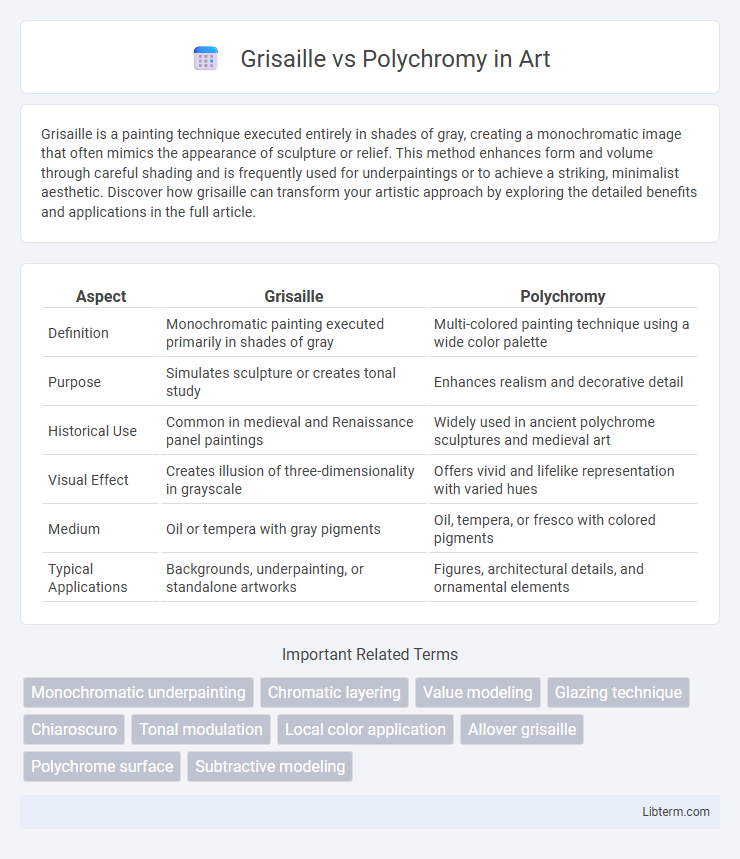Grisaille is a painting technique executed entirely in shades of gray, creating a monochromatic image that often mimics the appearance of sculpture or relief. This method enhances form and volume through careful shading and is frequently used for underpaintings or to achieve a striking, minimalist aesthetic. Discover how grisaille can transform your artistic approach by exploring the detailed benefits and applications in the full article.
Table of Comparison
| Aspect | Grisaille | Polychromy |
|---|---|---|
| Definition | Monochromatic painting executed primarily in shades of gray | Multi-colored painting technique using a wide color palette |
| Purpose | Simulates sculpture or creates tonal study | Enhances realism and decorative detail |
| Historical Use | Common in medieval and Renaissance panel paintings | Widely used in ancient polychrome sculptures and medieval art |
| Visual Effect | Creates illusion of three-dimensionality in grayscale | Offers vivid and lifelike representation with varied hues |
| Medium | Oil or tempera with gray pigments | Oil, tempera, or fresco with colored pigments |
| Typical Applications | Backgrounds, underpainting, or standalone artworks | Figures, architectural details, and ornamental elements |
Introduction to Grisaille and Polychromy
Grisaille is a painting technique executed entirely in shades of gray, often used to imitate sculpture or create a monochromatic effect emphasizing form and texture. Polychromy refers to the application of multiple colors in artwork, enhancing depth, realism, and visual impact through vibrant hues. Both techniques play crucial roles in art history, with grisaille serving as a study of light and shadow, while polychromy brings life and color to sculptures and paintings.
Historical Origins and Evolution
Grisaille, originating in the 14th century, emerged as a monochromatic painting technique imitating sculpture, predominantly used in Gothic and Renaissance art for stained glass and altarpieces. Polychromy, dating back to ancient civilizations like Egypt and Greece, involves the application of multiple colors to sculptures and architectural elements, evolving through the Middle Ages into a vibrant decorative art form. Both techniques highlight evolving cultural preferences for visual storytelling and artistic expression across different historical periods.
Defining Grisaille: Monochromatic Artistry
Grisaille is a monochromatic painting technique that uses shades of gray to create depth, volume, and intricate detail, often mimicking the appearance of sculpture. This method emphasizes light and shadow, allowing artists to focus on form and texture without the distraction of color. Grisaille serves as both a stand-alone artistic expression and a preparatory underpainting for polychromy, where vibrant colors enhance the monochrome foundation.
Understanding Polychromy: The Power of Color
Polychromy enhances sculptures and architectural elements by applying multiple vibrant colors, bringing lifelike depth and emotional intensity that grisaille's monochromatic palette lacks. This technique allows artists to highlight intricate details and create visual contrast, amplifying the artwork's narrative and sensory impact. The strategic use of varied pigments in polychromy enriches the viewer's experience by invoking realism and dynamic expression.
Artistic Techniques and Materials Used
Grisaille is an artistic technique using shades of gray to create monochromatic images that mimic sculpture, typically executed with oil or tempera paints on canvas or panel. Polychromy involves the application of multiple colors to sculptures, architectural elements, or paintings, employing pigments mixed with binders such as egg tempera, oil, or fresco plaster to achieve vibrant, lifelike effects. Grisaille emphasizes form and light through subtle tonal variations, while polychromy relies on a rich palette to enhance realism and decorative appeal.
Iconic Examples in Art History
Grisaille, exemplified by Jan van Eyck's Ghent Altarpiece panels, employs monochromatic shades to mimic sculpture, enhancing form and volume through grayscale tones. Polychromy, vividly displayed in Michelangelo's Sistine Chapel ceiling, uses a rich palette to convey lifelike color and emotional intensity, intensifying the visual narrative of biblical scenes. These contrasting techniques highlight the diverse methods artists use to evoke realism and symbolic meaning in religious and historical artworks.
Symbolism and Meaning in Grisaille vs Polychromy
Grisaille, characterized by monochromatic tones of gray, symbolizes purity, simplicity, and spiritual introspection, often evoking a sense of timelessness and solemnity in religious and classical artworks. Polychromy employs vibrant colors that embody life, diversity, and emotional expression, enhancing narrative depth and realism to convey complex stories and cultural symbolism. The choice between grisaille and polychromy profoundly influences the viewer's perception, where grisaille invites contemplation and polychromy stimulates sensory engagement and cultural interpretation.
Comparative Aesthetic Impact
Grisaille, characterized by monochromatic tones often in shades of gray, emphasizes form, texture, and light, creating a sculptural and meditative aesthetic. Polychromy, with its vibrant and varied color palette, enhances visual richness and emotional expressiveness, engaging viewers through dynamic contrasts and depth. The comparative aesthetic impact reveals Grisaille's subtlety and restraint versus Polychromy's vividness and immediacy in artistic expression.
Influence on Contemporary Art
Grisaille and polychromy techniques have significantly shaped contemporary art by influencing modern approaches to color and form. Grisaille's monochromatic palette emphasizes texture and tonal variation, inspiring minimalist and abstract artists to explore depth without relying on color. In contrast, polychromy's vibrant use of multiple colors encourages contemporary creators to experiment with bold contrasts and dynamic compositions, enriching visual storytelling and emotional impact.
Conclusion: Choosing Between Grisaille and Polychromy
Choosing between grisaille and polychromy depends on the desired visual impact and thematic expression in art. Grisaille, characterized by monochromatic shades of gray, emphasizes form, texture, and light contrast, making it ideal for creating sculptural illusions or somber moods. Polychromy, featuring vibrant colors, enhances realism and emotional depth, making it suitable for dynamic, vivid storytelling in paintings or sculptures.
Grisaille Infographic

 libterm.com
libterm.com